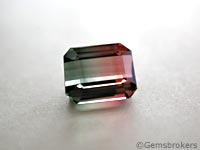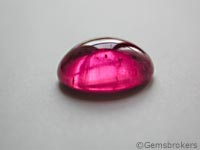Gemstones
- Agate
- Alexandrite
- Amber
- Amethyst
- Aquamarine
- Aventurine quartz
- Bloodstone
- Carnelian
- Cat's eye
- Chrysoberyl
- Chrysoprase
- Citrine
- Coral
- Demantoid garnet
- Diamond
- Emerald
- Garnet
- Iolite
- Labradorite
- Lapis lazuli
- Mandarin garnet
- Moonstone
- Onyx
- Opal
- Peridot
- Rock crystal
- Rose quartz
- Ruby
- Rutile quartz
- Sapphire
- Smoky quartz
- Spinel
- Sunstone
- Tanzanite
- Tiger's eye
- Topaz
- Tourmaline
- Tsavorite
- Turquoise
- Zircon
Tourmaline

Origin and technical
The name tourmaline comes from a Singhalese word, « touramalli », meaning "mixed colored stones" and was originally applied to an assortment of colored stones consisting mainly of zircons.Mineralogists gave tourmaline a variety of names, such as elbaite, tsilaisite, dravite, chromdravite, liddicoatite, uvite, schorl, achroite, buergerite, feruvite, foitite, povondraite and rubellite.
Tourmaline occurs in every color of the rainbow and also in combinations of two or three colors.
Sometimes the colors are at different ends of the crystal, while other times one color is in the heart of the crystal and another on the outside. When the later combination displays a pink center with a green rind it is called "watermelon tourmaline".
Tourmaline has another feature that attracted the attention of scientists since ancient times.
The philosopher Theophrastus wrote 23 centuries ago that "lyngourion", probably the mineral tourmaline, had the property of attracting straws and bits of wood. This effect, called pyroelectricity, occurs when the crystal is heated, causing it to yield a positive charge at one end of the crystal and a negative charge at the other and attract light weight substances.
This is why tourmaline was called “asshentrekers” or ash drawers by the Dutch during the eighteenth century.
An electrical charge can also be induced in some tourmaline crystals simply by applying pressure to the crystal in the direction of the vertical crystal axis.
This effect is known as piezoelectricity, and found many uses in pressure measuring equipment and other scientific applications: Tourmaline was used in the production of pressure sensitive gauges for submarine instrumentation as well as other war equipment.
The pressure gauges that measured the power of the first atomic bomb blasts were made with slices of this gem.
Myths and facts
The ability of this stone to look like other gemstones led to some confusions.Many gemstones in the Russian Crown jewels from the 17th Century once thought to be rubies are in fact tourmalines.
In South America, where the majority of such gem-quality material is found, green tourmaline is still referred to as the "Brazilian emerald".
The quantity of such green stones which were mined in the early days of the Portuguese colonization and sent to Portugal as emerald will probably never be known.
 Tourmaline was prized as a gem through history, but her main admirer was Tzu Hsi, the Dowager Empress who ruled China with an iron hand from 1860 until her death in 1908.
This last Empress of the Ch'ing Dynasty loved this stone so much that she bought enormous quantities of it, principally of the pink variety.
Tourmaline was prized as a gem through history, but her main admirer was Tzu Hsi, the Dowager Empress who ruled China with an iron hand from 1860 until her death in 1908.
This last Empress of the Ch'ing Dynasty loved this stone so much that she bought enormous quantities of it, principally of the pink variety.The last Empress of the Ch' ing Dynasty was so passionate about this stone that she bought huge quantities of it, mostly of pink color from mines discovered during her reign in California. The stone was used mainly in carvings, watch chain bars, or jacket buttons worn by the Imperial Court and some wealthy personalities.
Mining and production of this gem was entrusted to Mr. Tannenbaum, gemologist of the Tiffany jewellery house, who, on the orders of the Empress, asked the miners to dig and ship the material from the Mesa Grande and Pala deposits to New York, where it was finally shipped to China. The San Diego Tourmaline Mining Company was established, bringing together the various deposits in the area such as the Himalaya, Green Lodge, Payne, Stewart, Vanderberg, Katerina and Tourmaline King mines.
The funds needed for the operation were provided directly by the Empress and made the wealth of the Import Export Bank of New York absorbed by the Chase National, becoming later Chase Manhattan, now owned by J.P. Morgan Chase & Co.
Since her death, her body rests eternally on a tourmaline pillow.
In 1989, Brazilian miners discovered tourmaline unlike any that had ever been seen before.
This new type of tourmaline, which soon became known as Paraiba tourmaline, came in incredibly vivid blues and greens, due to copper sulfate added to a tiny amount of gold as coloring agent.
This very rare stone demands extremely high prices on the market today.
Tourmalines are credited with the power to enhance one's understanding, increase self-confidence and amplify one's psychic energies, and aid in concentration and communication.
Conversely, they are said to neutralize negative energies, and dispell fear and grief.
Tourmalines were also believed to be usefull in relaxing the body and the mind, and to help in the treatment of many different diseases such as anxiety, blood poisoning, arthritis, and heart disease.
Tourmaline is the birthstone for October and corresponds to the astrological sign of the Libra.
Consult list of gems available on the Chanthaburi market...
Consult list of gems available on the Jaipur market...




